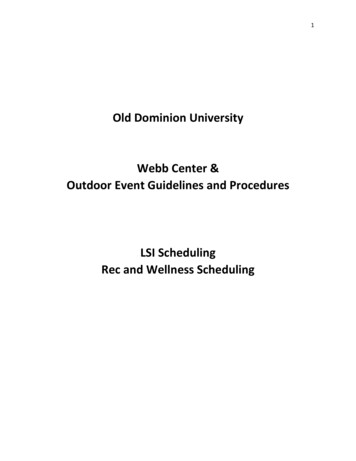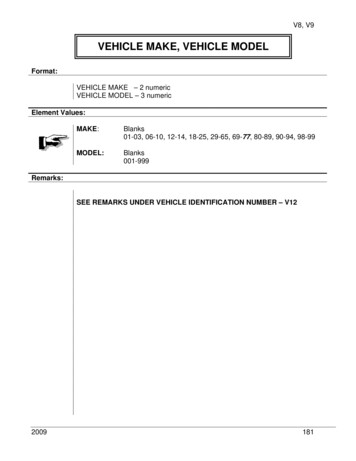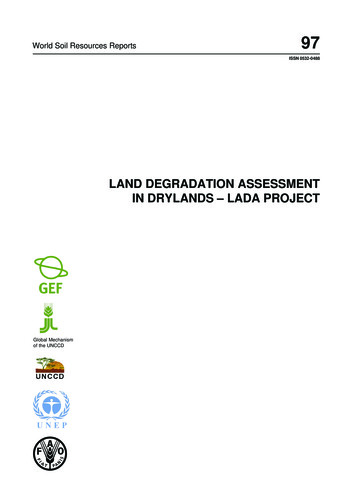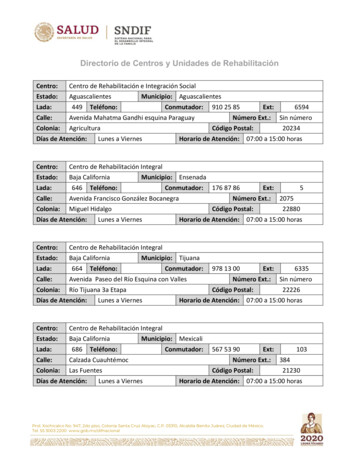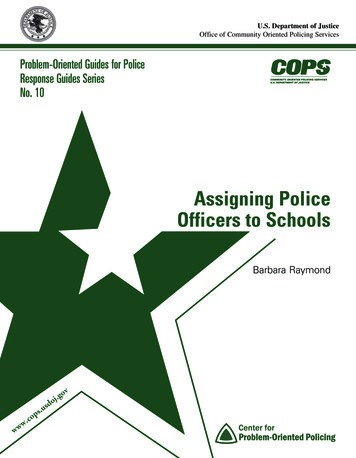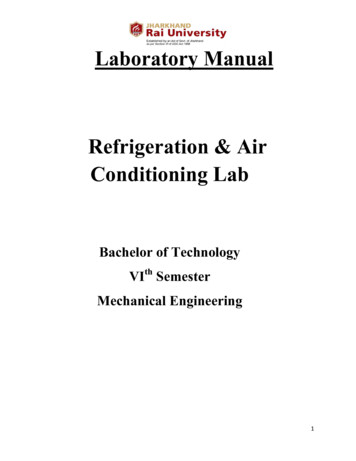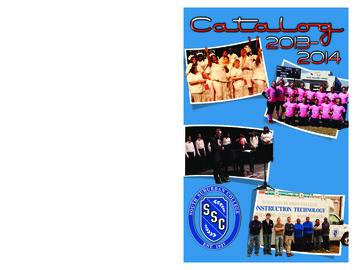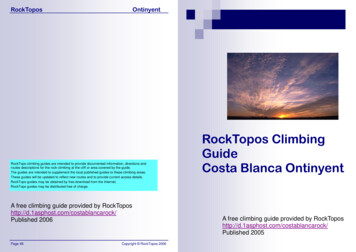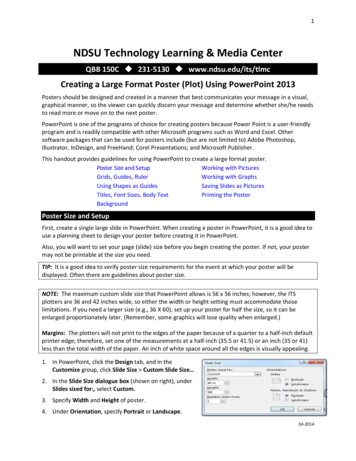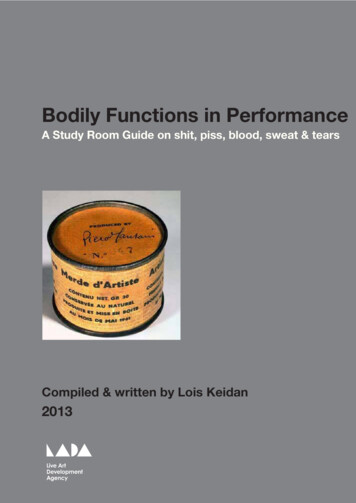
Transcription
LADA Study Room GuidesAs part of the continuous development of the Study Room we regularly commission artistsand thinkers to write personal Study Room Guides on specific themes.The idea is to help navigate Study Room users through the resource, enable them toexperience the materials in a new way and highlight materials that they may not haveotherwise come across.All Study Room Guides are available to view in our Study Room, or can be viewed and/ordownloaded directly from their Study Room catalogue entry.Please note that materials in the Study Room are continually being acquired and updated.For details of related titles acquired since the publication of this Guide search the onlineStudy Room catalogue with relevant keywords and use the advance search function tofurther search by category and date.Cover Image credit: Piero Manzoni, Merda d’artista, 1961
Bodily FunctionsIn PerformanceA Study Room Guide onShit, Piss, Blood, SweatAnd Tears.1
2
The following are notes for Lois Keidan’s presentation for Blackmarket No 11 2008, on thetheme of bodily functions in performance, with added images and recommendations forfurther research and study.Blackmarket for Useful Knowledge and Non-Knowledge No 11On WASTE: The Disappearance and Comeback of ThingsSaturday 29 November, 2008, LiverpoolA Blackmarket is an interdisciplinary research on learning and un-learning where narrativeformats of knowledge transfer are tried out and presented. The installation imitates familiarplaces of knowledge exchange, like the archive or library reading room, and combines themwith communication situations such as markets, stock exchanges, counselling or socialservice interviews.Each Blackmarket presents a different topic, generating an encyclopaedia with local experts.In Liverpool, the theme dealt with the relationship between human beings and their materialworld, the moment when things lose their form, deteriorate, rot, explode, slide into decay;and when remembrance and forgetting lose their distinction. In our economy of waste,garbage is the repressed side of consumption, whilst non-biodegradable, radioactive toxinshave made waste an ecological survival problem. In response to this we have developed arange of methods to stabilise waste, such as recycling, burning, conserving or archiving.Blackmarket No 11 was part of the Bluecoat’s Liverpool Live programme for the LiverpoolBiennial 2008 (P1126). Presented in association with the Live Art Development Agency.Supported by Arts Council England, Liverpool Culture Company and the Goethe InstituteManchester.www.mobileacademy-berlin.com3
IntroductionEver since visual artists of the late 20th century rejected objectsand markets and turned to their own bodies as the site andmaterial of art, the radical methodologies of performance arthave continued to influence artists working at the edges ofvisual art, theatre, dance and other contemporary disciplines.This gene pool of practices and approaches is referred to in theUK and increasingly elsewhere as Live Art and is now widelyunderstood to be one of the most vibrant creative practices andinstrumental cultural contexts for artists who are working acrossforms, contexts and spaces to open up new artistic models, newlanguages for the representation of ideas and identities, new waysof activating audiences, and new strategies for intervening inpublic life.Live Art is impossible to define or fix, but central to much of thework that can be framed by this term is an investment in ideas ofprocess and presence rather than the making of things. Live Artis concerned with the nature and the experience of art, and oftenpursues these concerns through the employment of the body asboth its object and subject.For many artists the body is a loaded and potent site andone has only to consider the performance work of MarinaAbramović, Chris Burden, Joseph Beuys, the Vienna Aktionists,Gina Pane and Stelarc in the 1960s and 1970s to understandthe transgressive history of the body in relation to art and thesignificance of art in relation to the body. And Live Art continuesto evolve as a space to embody a whole range of urgent andcomplex cultural discourses - for artists who are for exampleconcerned with the negotiation and representation of racial,sexual and gender identity, their bodies are politically investedsites to break apart traditions of representation.4
For other contemporary artists the body in performance is a forceto destroy pretence, to create sensory immersion, to shock, torepulse, to seduce, and to open up different kinds of engagementwith meaning. Many artists who place the body at the centre oftheir practice are making highly charged, visceral, provocative,and sometimes explosive, work – often involving rare levels ofexposure, endurance, and intimacy. For them their body is anactive, transgressive site to reveal, expose and explore their verybeing in all its complexities, difficulties, desires, dirt, beauty andugliness. Forcing contact with the body, as the US writer C. Carrhas said, ‘as it is and not necessarily as it is imagined’, their workis central to contemporary debates around the politics of the body.And bodily functions, our own unique but universal wasteproducts, can be a provocative and potent material for artists totest the limits of art, to explore ideas of being, to question notionsof cultural value, and to provoke different forms of engagementbetween themselves and their audiences.Lois KeidanDirector, Live Art Development Agency5
Shit6
Piero ManzoniMerda d’artista (1961)We’re going to start with shit and the most famous of shit artists - PieroManzoni. In Milan in the 60s Manzoni staged a series of radical exhibitionsof multiples including Corpi d’Aria (Bodies of Air) - an edition of 45 balloonsthat could be blown up by the buyer, or the artist himself, and Fiato d’Artista(Artist’s Breaths), a series of balloons, inflated and attached to a woodenbase inscribed “Piero Manzoni- Artist’s Breath”. Continuing his explorationsinto the limits of physicality, whilst critiquing the Art World’s preoccupationwith permanence and commodification of ideas, in 1961 Manzoni created90 small cans, sealed with the text Merda d’Artista (Artist’s Shit). Each 30gram can was priced by weight based on the current value of gold (around 1.12 a gram in 1960). According to Wikipedia one of the most recent cansto be auctioned, #19, sold on 26 February 2007 in the USA for 80,000 and,apparently, that “The contents of the cans remain a much-disputed enigma”(since opening them would destroy the value of the artwork). But I have noreason to doubt that the cans contain Manzoni’s own shit – the cans are7
not just a great joke, but a work with conceptual and aesthetic integrity thatis about the nature and value of art, and the nature and value of the humancondition. By placing the artist’s body in all its functionality at the centre ofthe debate, Manzoni has been hugely influence on artists for generations tocome.Stuart BrisleyMuseum of Ordure (2002)Stuart Brisley is widely regarded as the godfather of British performance art.He gained notoriety in the 60s and 70s for works that challenged his bodyphysically, psychologically and emotionally, often using the waste products ofbodily functions as his primary material. Like Nitsch and the Vienna Aktionists,he believed that denying the visceral reality of what is around us, includingvomit, blood and shit, demeans the wholeness of the human experience. In2002 he co founded the UK Museum of Ordure.“Everything that is represented in the UK Museum of Ordure (UKMO) issubject to the vagaries of an uncontrolled internal auto-destructive process(not a virus) which slowly deforms and disables all information held inthe museum. This is comparable to the decaying processes which affectall artifacts in museums, regardless of all attempts at preservation: theretouching, repainting, cleaning, etc, which are incorporated risks to the purityof artifacts when first acquired by museums.8
Even ‘successful’ renovations are subject to periodic changes resultingfrom shifts in conservation policies. Eventually (and in accordance with thefallibilities of memory) artifacts are institutionally, progressively, determinedlyand inadvertently altered by acts of conservation (sometimes unintentionalacts of institutional vandalism) until they cease to be recognisable as theobjects first acquired. Of course in both cases - in the virtual environmentand in the material world - the processes of generation, decay, and entropyare paramount. Museums are by this definition charged with achieving theimpossible.UKMO is primarily ‘immaterial’, but is no less susceptible to irrevocablechange, revealing hardly perceptible but accreting shifts in qualities ofappearance, meaning, and information, even as it consciously attempts tomaintain the seamless surface of ‘the museum’ as a custodian or guardianof culture By continuing to preserve itself and at the same time embracethe inviolability of change, it asserts that changes wrought beyond themuseum’s control neither lower nor raise the values of the artifact in its remit.Are we witness to the death of something and the birth of something else?UKMO embraces all that changes while attempting to preserve productivecontradiction and undetermined resolutions. It suggests a restless state ofthings and thinglessness, a dimension in the state of ‘becoming’, whereredundant values may come to rest”.9
David Hoyle and PutaMagazine (2008)David Hoyle is a Manchester based performance phenomenon and possiblyone of the most outrageous and brilliant artists in the UK. In the late 90s, asThe Divine David he revolutionized queer culture through shows and eventsthat were part “end of the pier” showbiz, part performance art and partmayhem as he trod a path between incitement and abject danger.Adored by audiences and critics alike in 2000 The Divine David retired frompublic life (stating that “the world needs another gurning celebrity like itneeds a hole in the head”), but David Hoyle returned to the stage in 2006with a weekly edition of the performance event Magazine, presented byDuckie at the Royal Vauxhall Tavern in London. With a topical weekly editorial(politics, immigration, god etc.) Magazine featured special guests who wereinterviewed by David at the centre of an evening show characterized byfiercely political rants, wild guest performers, and ended with one of David’ssignature action paintings. One edition in the 2008 series of Magazine wasabout Arts Council England and the guest artist was Puta from Berlin, an artistspecializing in scatological performance.10
Piss11
Mad for RealTwo artists piss on Duchamp’s urinal (2000)Mad for Real are London-based Chinese performance artists who see the cityas their gallery and stage: performing public pranks to provoke debate aboutsocio political issues and cultural values and asking what art is and what canit do. Often literal in their references and materials (for example having publicfood fights using soya sauce and ketchup fights to symbolize East and Westcultural differences and conflicts, seeing Tracy Emin’s bed as a bed and notan artwork), they reappropriate ‘ready-mades’ as the functional things theyare. In 2000 they staged an intervention in the galleries of Tate Modern, usingDuchamp’s Fountain as it was originally intended to be – a urinal.12
Lisa WesleyGoin’ Gone (1999)Lisa Wesley’s piece Goin.Gone took place in a space strewn with thousandsof copies of pages from a five-act play (complete with character namesand stage directions). Sitting at a pub table and drinking a pint of her ownpiss she performed, almost to herself, the given drama (which was a kind ofTim Etchells-esque narrative about Saturday night lowlife in pursuit of sex,oblivion and redemption) over and over and over again. But at each point inthe cycle of repetition her body became increasing absorbed by/immersedin the narrative - the texts become concrete as she literally consumed all thepeanuts, crisps, condoms and piss that are the trappings of a night out in anyBritish city. She scrawled fragments of the text onto herself and sellotapedpages of the manuscript all over her body until she literally disappeared intoit.13
Jerome BelJerome Bel (1995)French choreographer Jerome Bel has re-imagined the possibilities of danceby developing a kind of anti-dance - stripping dance back to its basics ofmovement in time and space. Using a language of symbols and codes he letshis performers’ bodies, or the objects linked to them, tell their own story.Jerome Bel, from 1995, is the company’s signature piece and remains one oftheir most acclaimed works.“Enumeration and revelation, rhyme and poetry are the constants of the workof Jerome Bel - Any dominant principle is here held in check, even when thematter is about sexuality and eroticism.” L’Humanite“Flesh is the centre of this exploration which indisposes, irritates, delights,amuses but doesn’t let you stay indifferent. “ Le Soir14
Blood15
Franko BOh Lover Boy (2001)Working with sculpture, painting, photography, video and live action, the UKbased Italian artist Franko B is at the forefront of artists testing not only thelimits of the permissible in representations of the body, but the limits of thematerial body itself. In Franko B’s live work his abject, naked, monochromaticand bleeding body is a site to express the sacred, the profane and theunspeakable and an invitation to witness the human condition at its mostcarnal, exposed and essential. In a culture where images of violence andextremity have become daily entertainment, Franko B employs his bleedingbody as an affirmation of life and beauty and makes the unbearable bearable.In Oh Lover Boy he lies on a tilted white canvas with canulas in his arms andhis blood slowly flows down the canvas in rivulets, he leaves imprints of hisbody on the canvas.16
Ron AtheyIncorruptible Flesh(2006)Many artists working with their bodies in such visceral ways have engagedwith pain, suffering and endurance in their work. Sometimes as a means topersonal transcendence, sometimes as a means of catharsis for society,sometimes to signify the obsolescence of the body in a technological ageand sometimes to confront us with our own demons - the demons we oftenchose to deny or ignore. Indeed notions of pain and art, blood and ritualgo way back - as Mary Renault wrote of Greek mythology “when bloodsacrifice is abandoned it must be replaced by a ritual created by an artist”.Performance Art took up this challenge and ran with it and as we see in thework of Ron Athey are still running with it. The blood and pain in Athey’swork are a continuation of the influential legacy of Eurocentric PerformanceArt traditions. It is what the blood and pain in Athey’s work represents andsignifies that singles it out as such potent and politicised work about ourtimes and of our times.Taking himself, his performers and his audience to the limits of physical andemotional endurance, Ron Athey’s early extraordinary performance languagerevolves around feverish religious tableaux and scenes of ritualistic piercingand blood-letting. As an HIV positive man dealing with the taboos of blood,pain and death, as a gay man negotiating love, sex and life, as an atheistraised under the overwhelming shadow of the Pentecostal church, as atattooed and pierced Modern Primitive and as an artist demonised by thereligious and political right in the USA, Ron Athey’s work touches upon someof our harshest realities and darker truths.17
Kira O’ReillyWet Cup (2000)Kira O’Reilly’s early work was concerned with “the opening up of the body”and often involved controlled acts of body marking and blood-letting. InBad Humours/Affected, she placed a pair of leeches on her back and, asthey slowly sucked away on her inviting flesh, trickles of blood flowed downher back and her long white skirt. For Wet Cup and Unknowing she workedwith another age old ‘treatment’ for troubled women, wet cupping, a similartechnique to purging-by-leech but using heated suction cups and scalpels.Kira uses her bleeding and bloodied body as a physical and metaphoricalsignifier to contest identity politics and as an act of exposure, and control, ofthe self – herself.Kira’s blood based performances are, highly charged and uncomfortable; theyare not easy - on her or on us. They ask you to bear witness to an action youmay not want to see and to consider something you might prefer to ignoreand, in the process, they implicate you. They are raw and brutal but alsocaptivating, touching and haunting, engaging you emotionally, physically andintellectually. They are ‘experiences’, like the experience of body itself, thatare beyond language.18
Sweat19
Yann MarussichBlue Remix (2008)Blue Remix is an hour-long motionless performance by Swiss artist YannMarussich sitting in a transparent container. A journey through the skin, thework externalizes the internal motion of his body through the ingestion of alarge amount of methylene blue that gradually exits his body as his sweat.With thermal regulation and precise timings, Marussich creates a controlledbiochemical choreography of methylene blue as it progressively seeps outof all the orifices in his body - from eyes, mouth and nose and eventuallythrough the permeable membrane of the skin. By constructing a performanceenvironment in which he is framed within a transparent box (like an artobject) and remains motionless throughout he forces our attention is on thecontinuous inner movement of the body – of his body, of all bodies. As BrianDegger wrote in Transitlab about Marussich’s performance at FACT, Liverpool“It is profound and scary, and extreme. His rigidity in the performance belliesthe fact that as bodies we are always in motion, and in a disequilibriumwith the surrounding environment. We are anything but sustainable, but ourborders are semi-permiable“.20
Tue GreenfortCondensation (2008)For Frieze Art Fair 2008 the Danish artist Tue Greenfort excavated a chamberbetween gallery stands to present an installation that was literally adistillation of the essence of visitors to the fair. While inside a darkened roomfilled with the sound of waves, dehumidification equipment imperceptiblyextracted moisture from unsuspecting visitors - collecting sweat and breathand pumping it through plastic tubing into recycled water bottles, visible in aglass-walled aperture. Greenfort wants us to think about our relationship withwater, and the ecological wastefulness of drinking the fancy imported stuff.21
Lone TwinDays of Sledgehammer (2004)Barry Laing wrote in Realtime “Lone Twin are ‘ecologists’. In The Days ofthe Sledgehammer Have Gone, enthusiastically engaged in “becomingthe weather”, they ponder the “sinister and ludicrous past” of water as itcirculates in the perpetual hydrological cycle including rivers, clouds, rain—and us. The human body is 75% water and therefore inextricably implicatedin this cycle. Gary wonders if these ‘waters’, passed as sweat, may have beenencountered before: “my sweat, your sweat, Jimmy Connors’ sweat, BruceSpringsteen’s sweat—which happens to be Gregg’s favourite sweat at themoment.” Sweat figures crucially as the by-product of labour, endurance anda commitment to the completion of extreme physical tasks.Clad inappropriately in Army surplus ponchos and hiking shoes, variousparaphernalia including Norwegian hunting horns and with the ubiquitousclipboards slung around their necks, Lone Twin attempt to make a cloud!Concealed beneath the ponchos, each performer labours buried in multiplelayers of clothing, accumulating body heat: Gregg for 6 hours collecting waterfrom the Yarra river that day, Gary for much of the performance with verticalrows of theatre lights one foot away, performing a rain dance that looks likedog-paddle standing up. “This is what I do to feel a part of things; this is whatI do to blur my edges.” Either side of more stories and ‘points’, increasinglyfunny, entangled, gentle, yearning and touching on acts of kindness, theaudience is invited to throw cups of Yarra water over Gary and Gregg’s bare22
torsos—the burden of clothing now removed, rapid evaporation, a cloud.The clouds failed to appear, or we failed to see them. Trying to be helpful, 2women bending over perilously close to Gary exclaimed: “But there’s steamcoming from his pants!” Everyone laughing, talking, grinning. Becoming a partof something, regardless.Lone Twin understand that it can rain in the mind, and imagination in this workis miraculously transformed into, and imbibed by, sweat; the body, findingfatigue and water, forced to find another place, time and form to flow in. Theimaginal is made ‘material’ or realised in the cycle entered into, the economy,the ecology of a vast set of possible inter-connections and relationships”.23
Tears24
Stacy MakishiYou Are Here, But Where Am I?(2002)Describing herself as a transplant from Hawaii, Stacy Makishi’s work is oftentold from the point of view of the foreigner. The foreigner confronts us witha projection of our own strangeness, our own foreignness. In her work thereappears to be a tension between here and elsewhere, longing and belonging,desire and repulsion: the body constantly craving what is foreign, all the whilehomesick for what is familiar.You Are Here.But Where Am I? was created for the Liverpool Biennial 2002in response to the mythologies of a Liverpool, both foreign and familiar.Armed with a symbolic suitcase, Makishi performed a series of playful andpoignant actions in charged sites of departure and arrival around the citycentre – Albert Dock, Lime Street Station. Part ritual and part intervention, itwas a piece about partings and our painful and magnetic yearnings for theexotic isle of ‘elsewhere’.The central image of You Are Here was Stacy Makishi catching her tears.She was trying to mark the journey of a person who crossed two oceans (saltwater under the foot) and the tears that these journeys induced.She wrote “I was attached to a saline drip which dripped tears down my eyes.There were two funnels placed below my eyes that would catch the tearsand filter them down my body via tubes that ran all the way down to my feet.Under each foot there were two rubber pumps that would catch the waterand then with each step I took, would pump the water all the way up over my25
head and down my cheeks as tears once again. While I performed with thisapparatus at Lime Street Station, I performed foreignness. I was an islander,not of the continent, an incontinent, surrounded by an ocean of tears. Withevery step I took, I produced another tidal wave of tears.There is an illness associated to Alzheimer’s called pathological crying oremotional incontinence. I’m interested in the word Alzheimer. Alz-heim-er.‘Heim’ is the German word for home, or homeward. I wonder if Alzheimer’s ishaving chronic homesickness? Freud says love is homesickness.”Hayley NewmanCrying Glasses (An Aid to Melancholia) (1995)“The photographs in the series Connotations – Performance Images areconstructed images intended to explore the role of documentation inperformance. It is a series of 21 photo/text works documenting the fictionalcareer of a performance artist and was made as both a celebration andanalysis of the performance canon. The photographs in the series werestaged and performed by myself with most of the images being taken bythe photographer Casey Orr over a week in the summer of 1998. The dates,locations, photographers and contexts for the performances cited in the textpanels are fictional. In all instances the action had to be performed for thephotograph but did not take place within the circumstances or places outlinedin the supporting text.As a form, performance is often mediated through the documentary image,video, film, text or by word of mouth and rumour. With so few existingnetworks for the distribution of performances works, it is the image and26
its supporting text that is given precedence in publications on the subject,creating a handful of historical performances that have become notoriousthrough their own documentation, leaving others behind that have not madethe translation into the single image”.Crying Glasses (An Aid to Melancholia) (1995)On public transport in Hamburg, Berlin, Rostock, London and Guildford“Over a year I wore the crying glasses while travelling on public transport inall the cities I visited. The glasses functioned using a pump system which,hidden inside my jacket allowed me to pump water up out of the glasses andproduced a trickle of tears down my cheeks. The glasses were conceivedas a tool to enable the representation of feelings in public spaces. Over themonths of wearing the glasses they became an external mechanism whichenabled the manifestation of internal and unidentifiable emotions”.George ChakravarthiGenesis (1998)George Chakravarthi was born in New Delhi, India. He was brought up asa Catholic, schooled by one of its rigorous teaching Brotherhoods - yetbecause of other family influences, he also absorbed both Hindu andBuddhist philosophies. This childhood, filled with a complex, multi-culturaltrinity of deities, icons and belief systems, didn’t particularly affect ordisconcert him until his move to England at the age of ten. Settling in the UKwasn’t so much a re-location as a dislocation, triggering an ongoing processof exploration which now informs his work.27
After leaving full-time education at the age of sixteen. Chakravarthi spent histeenage years homeless, hustling and negotiating his way though Londonbefore enrolling for art school. There his continuing examination of his ownselfhood generated a practice and approach that deconstructs sociallyaccepted definitions of gender, sexual and racial identity, the intense scrutinyof his personal experience challenging those received wisdoms.Chakravarthi considers much of his work to be a series of self-portraits.As a multi-disciplinary artist he draws inspiration from cinema, art history,public and private spaces, and from collective social histories. Chakravarthiengages the viewer with his honest exploration of universal emotions. Usingexperiences from his own life, he often reveals painful situations, memoriesand experiences with an acute sensibility, cogent perceptions and generoushumanity.Genesis is performance to camera Filmed in real time, and explores humanemotions and physical metamorphosis as Chakravarthi reveals a series ofsentiments and passions.28
Study Room Resources for artists featured in this GuideGeneralP0553- Adrian Heathfield, Live: Art and Performance (2004) Features RonAthey, Franko B, Jerome Bel.P1126- Various, Liverpool Biennial – Engaging Art, People and Place(various Liverpool venues, 20th Sept- 30 Nov 2008) Various contributorsincluding Blackmarket for Useful Knowledge and Non-Knowledge,D1709 Various, Sacred at Chelsea Theatre: Bodily Functions – The Bodyin PerformanceVarious contributors including David Hoyle, Franko B, Ron Athey and Mad forRealV0416 – Various, The National Review of Live Art 2001 Extracts of workfrom, George Chakravarthi, Kira O’Reilly, Lisa Wesley and Franko BPiero Manzoniwww.pieromanzoni.orgStuart Brisleywww.ordure.orgP0250 – Szuper Gallery, Gallery Talks- Szuper GalleryPO418 - Stuart Brisley, The Collection of Ordure (2002)PO419 - Stuart Brisley, Beyond Reason: Ordure (2003)PO700 – Sandrine Meats, Stuart Brisley 1949 – 1981: Volume Premier:Texte (2005)PO701 – Sandrine Meats, Stuart Brisley 1949 – 1981: Volume Deuxieme:Annexes (2005)PO820 - Stuart Brisley, Stuart Brisley – Work 1958-2006 (2006)P1064 - Stuart Brisley, Crossings (2008)D1288 - Various, Liveartwork DVD 5 (2006) contains Stuart Brisley’s Last29
BreathsA0190 – Colin Perry, Stuart Brisley: Crossing (2008)V0603 - Stuart Brisley (a film by Ken McMullen), Ten DaysV0715 - Stuart Brisley, The Eye – Illuminations Series (2004)David HoyleD1015 - David Hoyle, David Hoyle Magazine 2008 – BackgroundProjectionD1123 - David Hoyle, Magazine – The ReprintD1401– David Hoyle, Sacred 2009- David Hoyle’s Theatre of TherapyNo. 6 of 26. For the complete series at SACRED see REF D1396-D1421D1413-D1419– David Hoyle, Sacred 2009- On the Couch with David HoyleNo. 18-24 of 26. For the complete series at SACRED see REF D1396-D1421D1660 – David Hoyle, Magazine: 10 Live performance essays by DavidHoyleD1691– David Hoyle, Bird la Bird, Lisa Blackman, Adrian Heathfield,Trashing Performance, Under and Overwhelmed: Emotion andPerformance, Panel DiscussionD1779– David Hoyle, Dave’s Drop-In Centre (2009)D1847– David Hoyle, Nathan Evans, Revelations: The Films of DavidHoyle and Nathan EvansD1857– Avant-Garde Alliance, Uncle David (2010)A0198 - David Hoyle, If you want theatre Hoyle at DuckieReview of DavidA0240 – Gavin Butt, ‘Hoyle’s Humility’ Dance Theatre Journal (2008,Vol.23, no.1, (pp.30-34)Mad For Real (Cai Yuan & Jian Jun Xi)www.madforreal.org30
P0685 – Cai Yuan & JJ Xi, Mad For RealP1382 – Mad For Real, One World One Dream: Aircraft Carrier Project(2009)D0129 – Yuan Cai and JJ Xi, Monkey Creates Havoc at the HeavenlyPalaceD0167 – Yuan Cai and JJ Xi, Mad For Real Compilation 1999-2003D0572 – Yuan Cai and JJ Xi Vital 2006 – International Chinese Live ArtFestivalD0675 – Yuan Cai and JJ Xi Vital 2006D0873 – Mad For Real Performance 1999-2003V0553 – Yuan Cai and JJ Xi Diao Jiu (Penis Wine) and Soya Sauce andKetchup Fight (2002)Lisa WesleyP1432 – Lisa Wesley Performance Texts (1999)D0558 – Lisa Wesley and Andrew Blackwood Performing RightsCollection – London – A Gallery of Utopias (2006)V0439 – Lisa Wesley Extracts: Tongue Will Split; Goin Gone;Maplethorpe DonkeyV0530 – Lisa Wesley When You Have Selected a Model, Life WithoutSoap, Tongue Will SplitV0645 – Lisa Wesley “Studio Starter” Extracts (2003)Jerome Belwww.jeromebel.frD0622 – Jerome Bel, The Last Performance (A Lecture) (1998)D1456 – J
forms, contexts and spaces to open up new artistic models, new languages for the representation of ideas and identities, new ways of activating audiences, and new strategies for intervening in . Live Art Development Agency. 6 Shit. 7 Piero Manzoni Merda d'artista (1961) We're going to start with shit and the most famous of shit artists .
